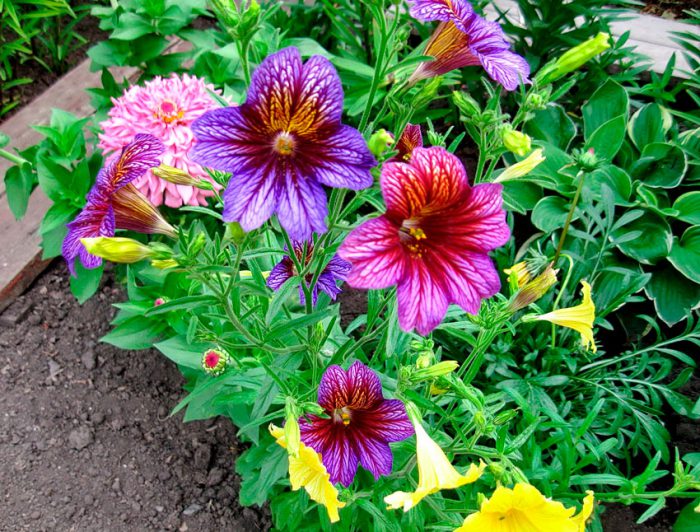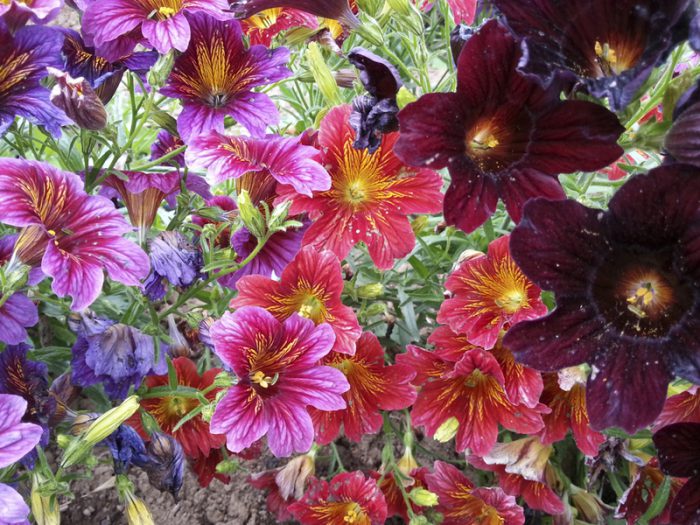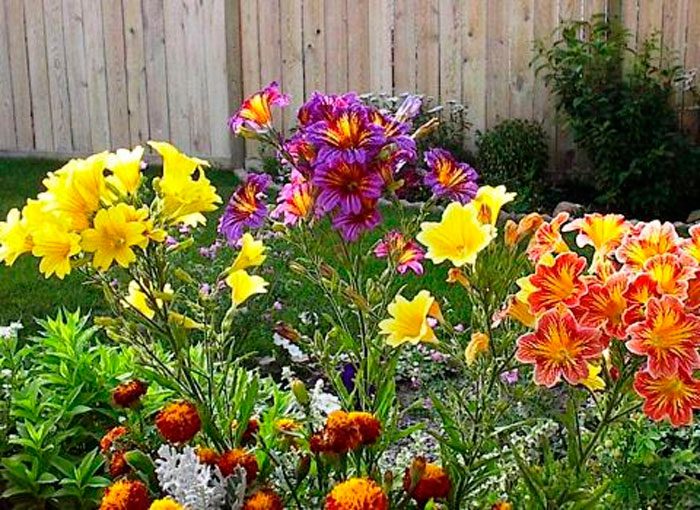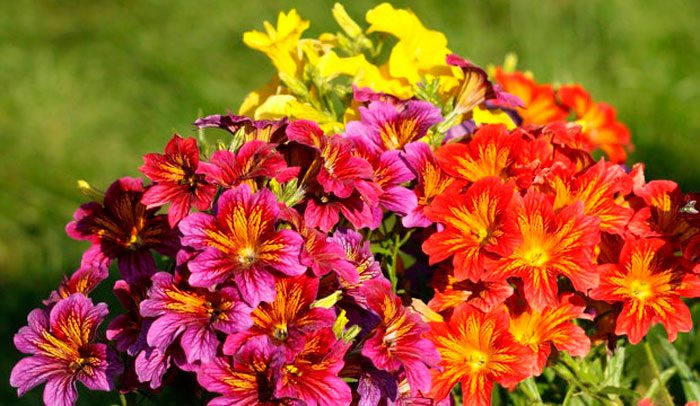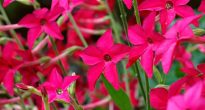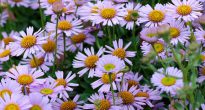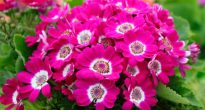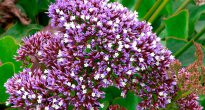Salpiglossis (Salpiglossis) is a genus of the Solanaceae family, which is represented by biennials, annuals and perennials. This genus unites about 20 species. The homeland of such a plant is South America, while it is most often found in Chile. The name salpiglossis contains 2 Greek words translated as "pipe" and "tongue", we are talking here about the shape of the flower. The plant also has a second name - pipe-tongue. Cultivated since 1820
Content
Features of salpiglossis
To date, only 1 species of this genus is cultivated by gardeners, namely: salpiglossis notched (Salpiglossis sinuata). Straight shoots can reach 100 centimeters in height, they are branched and thin, and there are glandular sticky hairs on their surface. The upper leaf plates are narrow, entire and sessile, while the basal plates are notched-lobed, oblong and have petioles. The diameter of single graceful flowers is 5 centimeters, their color can be blue, yellow, brown, purple or cream, on the surface of the pharynx there is a marble pattern consisting of veins of dark and golden color. Flowering is observed in June-October. The shape of the velvety-shiny flowers is funnel-shaped, they have a five-lobed limb. The fruit is a two-nested oval capsule, inside which small seeds are located.
In the middle latitudes, salpiglossis is grown only as a biennial or annual.
Growing salpiglossis from seeds
Sowing
Seeds are used to reproduce salpiglossis. Sowing for seedlings is carried out in the first days of March, for this they take not very deep, but rather wide containers, into which loose soil is poured. Then you need to distribute the seeds over the surface of the wet soil, while trying to make the distance between them as large as possible. The seeds are not buried in the soil, but simply pressed into its surface. The container must be covered with foil or glass and removed on a well-lit, cool (from 15 to 20 degrees) windowsill. To bring the seedlings closer to the surface, as well as to protect them from the scorching sunlight, a white piece of paper must be placed on the surface of the shelter.
Growing seedlings
When caring for seedlings, do not forget to systematically ventilate them, as well as remove condensation from the surface of the shelter.The first seedlings should appear after 15–20 days, but the film should not be removed immediately. First, it is removed for 1–2 hours, then it is removed for 3–4 hours, and when the plants are acclimatized to environmental conditions, the shelter is removed completely.
After the first pair of leaves appears at the plants, it will be necessary to pick them using cups or separate containers for this. When making a pick, be careful, as the delicate roots are very easily injured, and therefore the plants take root for a long time in a new place. After the seedlings begin to grow actively again, you should pinch its tops, this will increase its bushiness. Salpiglossis needs to provide moderate watering, while making sure that the substrate is not dry or too wet.
Planting salpiglossis in the ground
What time to plant
Planting mature and grown seedlings into open soil should be done only after the threat of return frosts has completely passed, as a rule, this time falls on the second half of May. Try to choose a well-lit area for planting that is sheltered from the wind. The nutrient soil should contain a large amount of humus, and its acidity can be neutral or slightly acidic.
How to plant
The site should be prepared approximately 7 days before the scheduled disembarkation day. To do this, they dig it up, while introducing a little sand, peat and wood ash into the soil. Between the holes, a distance of 25 to 30 centimeters should be observed, their depth should be such that not only the root system, but also an earthen lump could fit in them. Transfer the seedlings into the holes, and then cover them. The planted plants need abundant watering. Remember that this plant does not tolerate transplanting very well, so try to injure its root system as little as possible.
Salpiglossis care in the garden
When growing salpiglossis, there are several important points to keep in mind. So, it reacts extremely negatively to drought, stagnant water in the soil and subzero temperatures. Watering in the summer should be carried out once a day, while if the weather is hot, it is recommended to spray the bushes in the evening. In spring and autumn, the number of waterings should be only 2 or 3 per week. For irrigation, use lukewarm, well-settled water. At the end of watering, the surface of the site must be carefully loosened, at the same time weeding.
Pinch the bushes regularly, this will make the flowering more lush. Also, do not forget to promptly cut off the flowers that have begun to fade. If everything is done correctly, then salpiglossis will stop blooming only in October. Top dressing is carried out several times per season and for this purpose a complex mineral fertilizer is used for flowering plants. If you want to feed the plants with organic matter, then for this you should choose wood ash.
Diseases and pests
Such a moisture-loving plant, when grown in open soil, often gets sick with root or stem rot, as a result of which it dies. As soon as you notice that the plant is unhealthy, it is necessary to urgently treat the bush and the soil around it with a fungicide, and do not forget to adjust the watering regime. If the bush is very badly affected, then it is better to dig it up and burn it.
Aphids can settle on salpiglossis. To get rid of it, you need to treat the bush with acaricide.
After flowering
As a perennial, this plant is cultivated only in regions with a mild, warm climate. If the winters are frosty, then salpiglossis can only be grown as an annual, because after the frosts come, it will die.If you wish, you can try to plant such a flower in a pot in the autumn and bring it into the house, but it is unlikely that it will take root, because it reacts extremely negatively to the transplant.
Types and varieties of salpiglossis with photos and names
It has already been mentioned above that only salpiglossis notched is cultivated by gardeners. You can see a detailed description of this type at the beginning of the article. He has the following garden forms:
- Large-flowered... The height of the bush can reach 100 centimeters, its stems are branched. The flowers are large.
- Superbissima... Quite large flowers have corrugated petals.
- Salpiglossis low... Bushes strongly branch and reach a height of 0.4 m. It blooms very luxuriantly.
The most popular are the following hybrids and varieties:
- Kew Blue... The height of the undersized bush does not exceed 0.3 m. The flowers are painted in various shades of purple from purple to pink-lilac. Their throat is dark in color, and on the surface there is a sparse mesh of yellow veins.
- Casino mix... The height of the compact bush is from 0.45 to 0.5 m. The color of the flowers can be very different, even yellow. These colors need support.
- Festival and Flamenco. The height of the compact bushes of this plant does not exceed 0.3 m. The color of the flowers is varied.
- Bolero... The height of a lush flowering bush is about 0.6 m. The stem is quite stable.
- Ali Baba... Such an exotic annual plant reaches a height of 0.8 m. On the surface of the flowers there are contrasting veins, they stand very well in cut.
- Corduroy dolly... The height of the bushes is about 0.4 m. The diameter of the velvet flowers is about 60 mm, they have a bizarre appearance.
- Fireworks... Such a branchy plant blooms very luxuriantly and has a height of about 0.6 m. The diameter of the flowers is 60 mm, they can be colored purple, deep red or light pink, on their surface there are yellow-golden or dark purple streaks.
- Magic... The height of the bush varies from 0.4 to 0.6 m. The color of the flowers is snow-white, red, scarlet or purple, on the surface of the pharynx there is a marble pattern of yellow veins.

